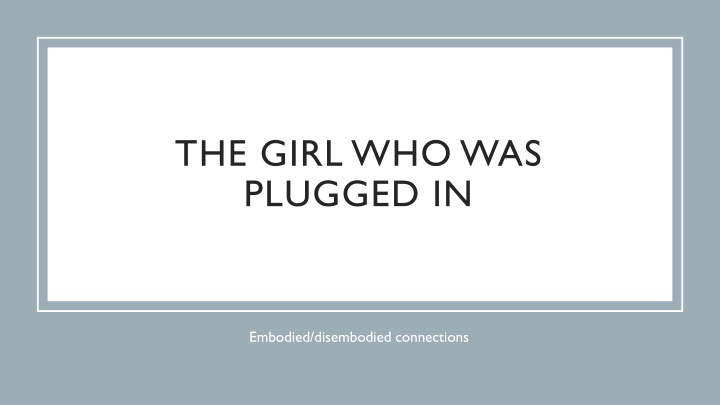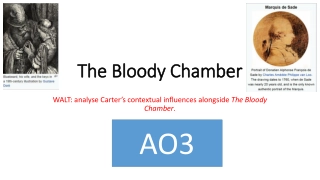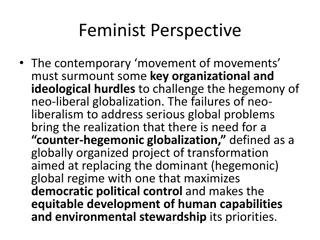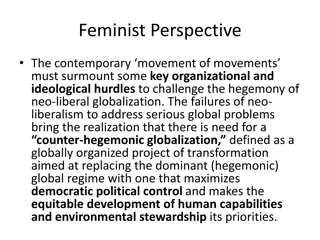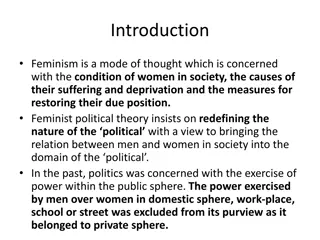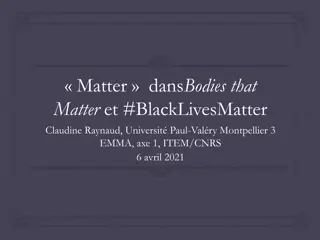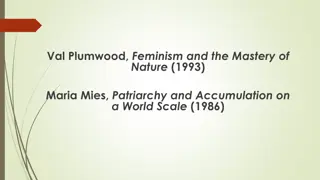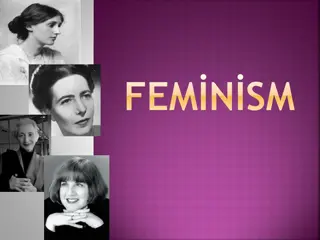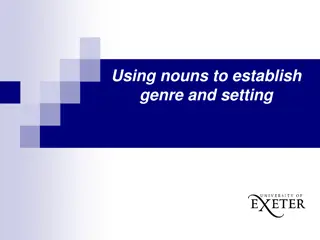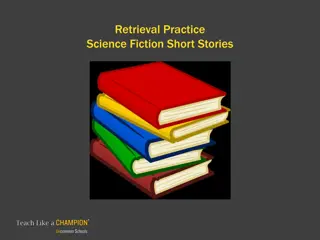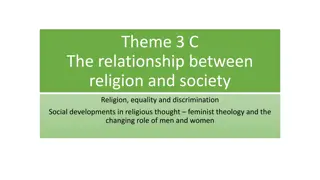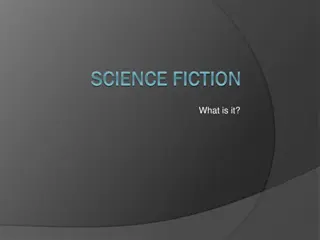The Girl Who Was Plugged In: A Feminist Perspective on Science Fiction
Embark on a journey through the thought-provoking narrative of "The Girl Who Was Plugged In" by James Tiptree Jr. (Alice Bradley Sheldon). Explore the intriguing blend of embodied and disembodied connections, as well as the themes of artificiality, idealized femininity, and societal injustices portrayed in this futuristic depiction of media and technology. Delve into the complexities of perfection, sacrifice, and the unseen labor that sustains a technologically advanced society through the lens of a satirical yet sensitive writer.
Download Presentation

Please find below an Image/Link to download the presentation.
The content on the website is provided AS IS for your information and personal use only. It may not be sold, licensed, or shared on other websites without obtaining consent from the author.If you encounter any issues during the download, it is possible that the publisher has removed the file from their server.
You are allowed to download the files provided on this website for personal or commercial use, subject to the condition that they are used lawfully. All files are the property of their respective owners.
The content on the website is provided AS IS for your information and personal use only. It may not be sold, licensed, or shared on other websites without obtaining consent from the author.
E N D
Presentation Transcript
THE GIRL WHO WAS PLUGGED IN Embodied/disembodied connections
JAMES TIPTREE JR., AKA ALICE BRADLEY SHELDON (1915-1987) From Science Fiction and its Contexts, edited by Heather Masri: Now often labeled a feminist writer, until the woman behind the pseudonym was revealed in 1977 he was alternately heralded as a distinctively masculine writer and condemned as a male chauvinist pig. Deliberately provocative and disturbing, at times even brutal, Tiptree is a satirist whose unflinching examination of cruelty and exploitation is tempered by humor and a keen sensitivity to the realities of loneliness and suffering. (342)
CONTD The daughter of Chicago socialites and explorers, Alice Bradley traveled extensively in Africa as a child and studied art as a young woman. She met her second husband, Huntington Sheldon, while working for U.S. Army Intelligence during World War II, and later joined the C.I.A. In 1967, she earned a doctorate in experimental psychology. It was only at the age of 51 that she began writing science fiction as James Tiptree Jr., but she soon received widespread recognition as one of the most exciting new voices in the field. In 1987, Alice Sheldon shot her invalid husband and then took her own life. (343)
Written in 1973, The Girl Who was Plugged In seems prescient in its depiction of the media landscape of the future, a world of glossy artificiality and ubiquitous marketing posing as life and entertainment. Delphi is ostensibly the personification of this artificial life a construct of idealized femininity, with muted feeling and empty of intelligence or will. FUTURE WORLD: APPEARANCE AND REALITY P. Burke and her underground existence are the dirty secret of this world imperfection, emotion the suffering of embodied life and the injustice of those whose bodies and lives don t fit the constructed ideal.
Like Ursula K. LeGuins story The Ones Who Walk Away From Omelas in which a utopian society s ideal life depends on the suffering of one child locked in a cellar, Tiptree s story shows us how the slick, reflective surfaces of a technological society (in which we enjoy seeing our idealized selves and long to become perfected) depend on the labor and suffering of the invisible, unseen, marginalized members who make that society run. PERFECTION AND SACRIFICE
NARRATOR AND POINT OF VIEW The narrator s distinct voice and attitude, combined with the second-person address ( you ) implicates the reader on the wrong side of the story, as an observer, distracted by the shiny world of the future. We are addressed as Zombie, dead daddy. The narrator says I d love to show you something and commands us, Watch. We come to this world from the past, hoping to capitalize on a glimpse into the future flowering of our own image-obsessed, market-driven world. Despite the narrator s brutal, even cruel, descriptions of P. Burke, from the beginning we get a sense that she is a victim of the society in which we are somehow implicated. In the scene where P. Burke tries to commit suicide on a park bench, we look from high above, and spend numerous paragraphs looking at the fabulous city of the future before we move our attention back down to her. We are complicit with the gods of this society, and No one ever told her about mortals who love a god and end up as a tree or a sighing sound.
As the story moves on and P. Burkes life becomes the animating spirit of Delphi, P. Burke herself becomes completely identified with the flesh-and-blood automaton who gets to live what P. Burke could never have dreamed. The descriptions of P. Burke in this merging of identity shift through the story, from she s just a girl, a real live girl with her brain in an unusual place, to that insignificant part of Delphi that lives five hundred feet under Carbondale, to who remembers that carcass? Certainly not P. Burke, she hasn t spoken through her own mouth for months. MERGING, SUSPENSION, LOSS OF SUBJECTIVITY She loses her subjectivity, but she experiences love for the first time.
WHAT IS A GIRL, ANYWAY? The narrator consistently refers to P. Burke as our girl, repeatedly bringing us back to both the sometimes-painful reality of being gendered girl, and the fact that our concepts of girl are constructions that we are trained to maintain. The irony is that Delphi, the so-called perfect girl, is also a pawn, an object used to further the ends of the powerful. Look, P. Burke is about as far as you can get from the concept girl. She s a female, yes but for her, sex is a four-letter word spelled P-A-I-N. She isn t quite a virgin. You don t want the details. The training is exactly what you d call a charm course. How to walk, sit, eat, speak, blow her nose, how to stumble, to urinate, to hiccup DELICIOUSLY. How to make each nose-blow or shrug delightfully, subtly different from any ever spooled before. As the man said it s hard work. Image opposite: Jean Harlow, 1930s movie star mentioned in the story
HYBRIDITY, FEEDBACK, CONNECTION In the end the victim P. Burke strangely subverts the project of her own disappearance. There are suggestions that Delphi has imbibed some sort of life from P. Burke as she moves, dreams, and even speaks when P. Burke is not plugged in to her. P. Burke experiences love: feels it in her own body even when Delphi s nervous system is insufficient, and, in a strange way, connects with Delphi, Paul, and the people around her and around Delphi. Although this may not be seen as a victory, she ultimately emerges and attempts to connect with Paul in her own body, but she is not seen. In the end she seeks Delphi: It s doubtful he [ ] sees her life coming out of her eyes at him. And at the las it doesn t go to him. The eyes find Delphi, fainting by the doorway, and die.
CONSIDER THIS (FOR DISCUSSION) Humanity is always already a construction, disassembled and reassembled, like Haraway's cyborg, from the parts at hand- most crucially, from the other beings in our worlds with their own partial and fractured identities (Haraway 163). This concept of the human takes account of its embedded nature, not only in the body, but also in the social sphere, and is sensitive to the reality that technology cannot replace the personal bonds that tie humans to humans, humans to animals, and humans to their own senses (Hayles 278). In such a crucible of intermeshed social performances, identities are formed and reformed and we never simply are, but are always in the process of becoming human. (101) Trying to Plug In: Posthuman Cyborgs and the Search for Connection by Melissa Colleen Stevenson
FOR DISCUSSION (CONTD) Humanity, much like gender, is a doing, not a being. It is a performance that must be repeatedly enacted and received. Haraway refers to writers of science fiction as "theorists for cyborgs" (173). As theorists for cyborg identity, both C.L. Moore and James Tiptree, Jr. show that it is not enough simply to escape our old bodies nor to cast off our prescribed gender identities. Cyborg identity cannot simply be about escape or "bodiless exaltation"; it must also be concerned with the bonds that tie individuals to one another and the necessary connections that define aligned networks and communities. Autonomy for the cyborg is both impossible and insufficient. In our flight from the constrictions of autonomous liberal subjectivity, it is very important, even crucial, that we do not go alone. In seeking to "plug in" to as yet untapped power and potential, we cannot forget the importance of connection. Trying to Plug In: Posthuman Cyborgs and the Search for Connection by Melissa Colleen Stevenson
QUESTIONS FOR FURTHER THOUGHT What does this story suggest about the political realities of a posthuman future? (Who will benefit? Who will be left out? Who will be used and thrown away? To what ends?) Does the future of humanity depend upon the relationship of technology to commerce? Compare P. Burke to Frankenstein s creature. What do they have in common? Compare Tiptree s satiric tone and vision to Haraway s ironic epistemology in the Manifesto. What is suggested by the story s use of irony?
